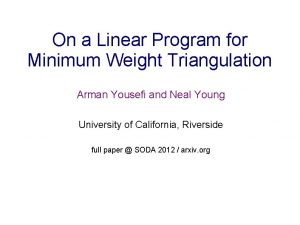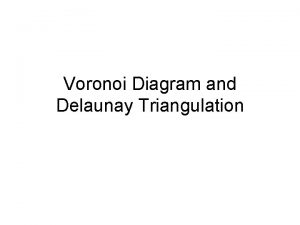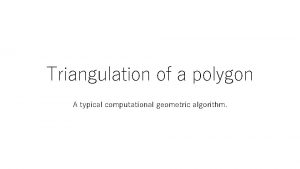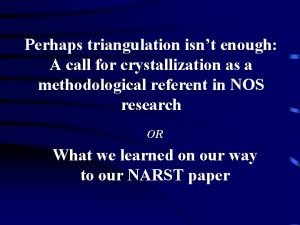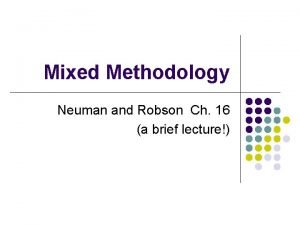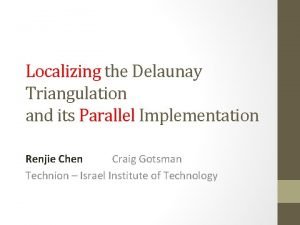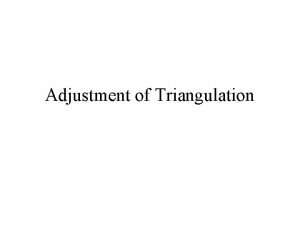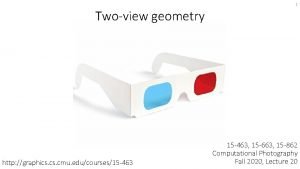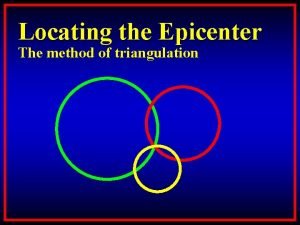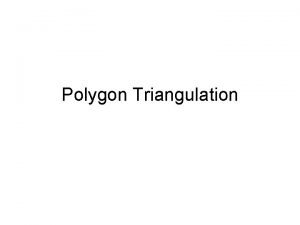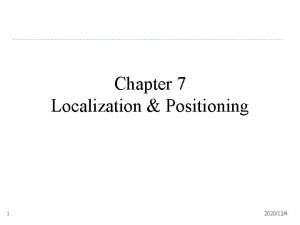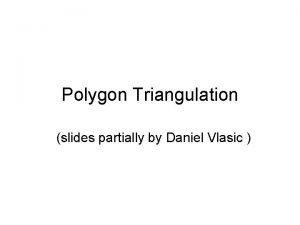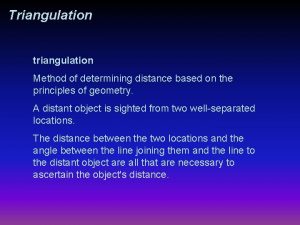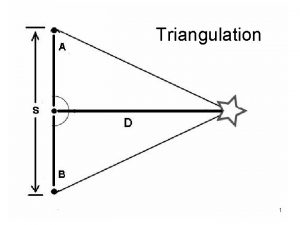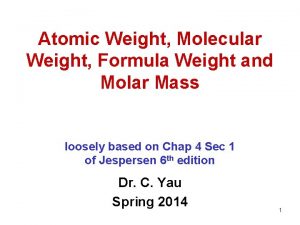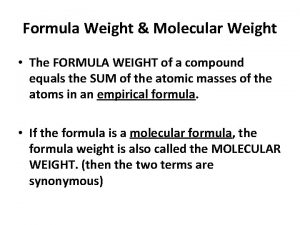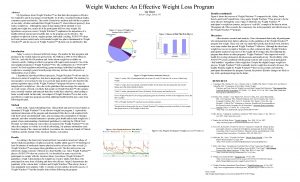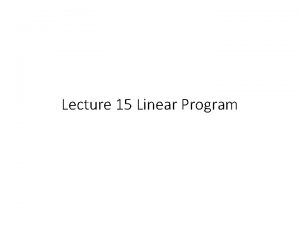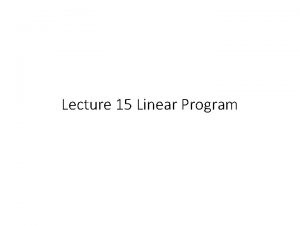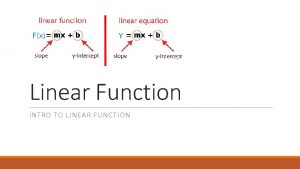On a Linear Program for Minimum Weight Triangulation
















![approximation algorithms l l l l [1987] Plaisted and Hong. A heuristic triangulation algorithm. approximation algorithms l l l l [1987] Plaisted and Hong. A heuristic triangulation algorithm.](https://slidetodoc.com/presentation_image/56a76d8bba5d85cf66f602004aaa51c0/image-17.jpg)









![linear programs for MWT [1985] Dantzig et al. l Triangulations (tilings) and certain block linear programs for MWT [1985] Dantzig et al. l Triangulations (tilings) and certain block](https://slidetodoc.com/presentation_image/56a76d8bba5d85cf66f602004aaa51c0/image-27.jpg)
![Dantzig et al’s triangle-based LP [1985] minimize subject to Dantzig et al’s triangle-based LP [1985] minimize subject to](https://slidetodoc.com/presentation_image/56a76d8bba5d85cf66f602004aaa51c0/image-28.jpg)
![Dantzig et al’s triangle-based LP [1985] minimize subject to Dantzig et al’s triangle-based LP [1985] minimize subject to](https://slidetodoc.com/presentation_image/56a76d8bba5d85cf66f602004aaa51c0/image-29.jpg)
![Dantzig et al’s triangle-based LP [1985] minimize subject to Dantzig et al’s triangle-based LP [1985] minimize subject to](https://slidetodoc.com/presentation_image/56a76d8bba5d85cf66f602004aaa51c0/image-30.jpg)
![Dantzig et al’s triangle-based LP [1985] minimize subject to Dantzig et al’s triangle-based LP [1985] minimize subject to](https://slidetodoc.com/presentation_image/56a76d8bba5d85cf66f602004aaa51c0/image-31.jpg)
![Dantzig et al’s triangle-based LP [1985] minimize subject to Dantzig et al’s triangle-based LP [1985] minimize subject to](https://slidetodoc.com/presentation_image/56a76d8bba5d85cf66f602004aaa51c0/image-32.jpg)
![Dantzig et al’s triangle-based LP [1985] minimize subject to Dantzig et al’s triangle-based LP [1985] minimize subject to](https://slidetodoc.com/presentation_image/56a76d8bba5d85cf66f602004aaa51c0/image-33.jpg)
![Dantzig et al’s triangle-based LP [1985] minimize subject to Exactly one of these triangles Dantzig et al’s triangle-based LP [1985] minimize subject to Exactly one of these triangles](https://slidetodoc.com/presentation_image/56a76d8bba5d85cf66f602004aaa51c0/image-34.jpg)





























- Slides: 63

On a Linear Program for Minimum Weight Triangulation Arman Yousefi and Neal Young University of California, Riverside full paper @ SODA 2012 / arxiv. org

min-weight triangulation of a simple polygon

min-weight triangulation of a simple polygon • dynamic programming • O(n 3) time

min-weight triangulation of a simple polygon • dynamic programming • O(n 3) time

min-weight triangulation of a simple polygon • dynamic programming • O(n 3) time

min-weight triangulation of a simple polygon X • dynamic programming • O(n 3) time

min-weight triangulation of a simple polygon X • dynamic programming • O(n 3) time

min-weight triangulation of a simple polygon • dynamic programming • O(n 3) time

min-weight triangulation of a simple polygon • dynamic programming • O(n 3) time l [1979] Gilbert. l [1980] Klincsek. Minimal triangulations of polygonal domains. New results on planar triangulations.

minimum weight triangulation (MWT) input: a set of points in the plane: output:

minimum weight triangulation (MWT) input: a set of points in the plane: output: a triangulation T

minimum weight triangulation (MWT) input: a set of points in the plane: output: a triangulation T of minimum weight,

the Bible (1979)

the Bible (1979)

the Bible (1979)

the Bible (1979) MWT NP-Hard? In P?
![approximation algorithms l l l l 1987 Plaisted and Hong A heuristic triangulation algorithm approximation algorithms l l l l [1987] Plaisted and Hong. A heuristic triangulation algorithm.](https://slidetodoc.com/presentation_image/56a76d8bba5d85cf66f602004aaa51c0/image-17.jpg)
approximation algorithms l l l l [1987] Plaisted and Hong. A heuristic triangulation algorithm. O(log n)-approx [1996] Levcopoulos and Krznaric. O(1)-approx Quasi-greedy triangulations approximating the minimum weight triangulation. [2006] Remy and Steger. QPTAS A quasi-polynomial time approximation scheme for minimum weight triangulation. hardness result l [2006] Mulzer and Rote. 25 years after G+J! Minimum weight triangulation is NP-hard. NP-HARD

heuristics! l edges that can’t be in any MWT: l diamond test a [1989 Das and Joseph; 2001 Drysdale et al. ] b

heuristics! l edges that can’t be in any MWT: l diamond test a [1989 Das and Joseph; 2001 Drysdale et al. ] π/4. 6 b

heuristics! l edges that can’t be in any MWT: l a diamond test π/4. 6 b [1989 Das and Joseph; 2001 Drysdale et al. ] l edges that have to be in every MWT: l mutual nearest neighbors l β-skeleton l locally minimal triangulation (“LMT-skeleton”) [1979 Gilbert; 1994 Yang et al] [1993 Keil; 1995 Yang; 1996 Cheng and Xu] [1997 Dickerson et al; 1998 Beirouti and Snoeyink; 1996 Cheng et al; 1999 Aichholzer et al; 1996 Belleville et al; 2002 Bose et al]

heuristics! 1. The boundary edges have to be in the MWT.

heuristics! 2. Use the heuristics to find more edges that have to be in the MWT.

heuristics! if you’re lucky. . . found edges connect all points to boundary. Then remaining regions are simple polygons.

heuristics! 3. Triangulate each remaining region optimally using the dynamic-programming algorithm.

heuristics! 3. Triangulate each remaining region optimally using the dynamic-programming algorithm.

heuristics l l l This approach solves most random 40, 000 -point instances. [Dickerson et al. '97] But. . for random instances, heuristics leave (in expectation) Ω(n) internal components (but hidden constant is astronomically small, 10 -51). [Bose et al. '02]
![linear programs for MWT 1985 Dantzig et al l Triangulations tilings and certain block linear programs for MWT [1985] Dantzig et al. l Triangulations (tilings) and certain block](https://slidetodoc.com/presentation_image/56a76d8bba5d85cf66f602004aaa51c0/image-27.jpg)
linear programs for MWT [1985] Dantzig et al. l Triangulations (tilings) and certain block triangular matrices. l l Subsequently studied in [1996 Loera et al; 2004 Kirsanov, etc. . . ] edge-based linear programs: l [1997] Kyoda et al. A branch-and-cut approach for minimum weight triangulation. l [1996] Kyoda. l l l A study of generating minimum weight triangulation within practical time. [1996] Ono et al. A package for triangulations. [1998] Tajima. Optimality and integer programming formulations of triangulations in general dimension. [2000] Aurenhammer and Xu. Optimal triangulations.
![Dantzig et als trianglebased LP 1985 minimize subject to Dantzig et al’s triangle-based LP [1985] minimize subject to](https://slidetodoc.com/presentation_image/56a76d8bba5d85cf66f602004aaa51c0/image-28.jpg)
Dantzig et al’s triangle-based LP [1985] minimize subject to
![Dantzig et als trianglebased LP 1985 minimize subject to Dantzig et al’s triangle-based LP [1985] minimize subject to](https://slidetodoc.com/presentation_image/56a76d8bba5d85cf66f602004aaa51c0/image-29.jpg)
Dantzig et al’s triangle-based LP [1985] minimize subject to
![Dantzig et als trianglebased LP 1985 minimize subject to Dantzig et al’s triangle-based LP [1985] minimize subject to](https://slidetodoc.com/presentation_image/56a76d8bba5d85cf66f602004aaa51c0/image-30.jpg)
Dantzig et al’s triangle-based LP [1985] minimize subject to
![Dantzig et als trianglebased LP 1985 minimize subject to Dantzig et al’s triangle-based LP [1985] minimize subject to](https://slidetodoc.com/presentation_image/56a76d8bba5d85cf66f602004aaa51c0/image-31.jpg)
Dantzig et al’s triangle-based LP [1985] minimize subject to
![Dantzig et als trianglebased LP 1985 minimize subject to Dantzig et al’s triangle-based LP [1985] minimize subject to](https://slidetodoc.com/presentation_image/56a76d8bba5d85cf66f602004aaa51c0/image-32.jpg)
Dantzig et al’s triangle-based LP [1985] minimize subject to
![Dantzig et als trianglebased LP 1985 minimize subject to Dantzig et al’s triangle-based LP [1985] minimize subject to](https://slidetodoc.com/presentation_image/56a76d8bba5d85cf66f602004aaa51c0/image-33.jpg)
Dantzig et al’s triangle-based LP [1985] minimize subject to
![Dantzig et als trianglebased LP 1985 minimize subject to Exactly one of these triangles Dantzig et al’s triangle-based LP [1985] minimize subject to Exactly one of these triangles](https://slidetodoc.com/presentation_image/56a76d8bba5d85cf66f602004aaa51c0/image-34.jpg)
Dantzig et al’s triangle-based LP [1985] minimize subject to Exactly one of these triangles must be in the triangulation. “Exact cover by triangles. ”

Integer vs. fractional MWT Integer MWT Fractional MWT Each triangle has weight 1/2

Integer vs. fractional MWT Integer MWT Fractional MWT Each triangle has weight 1/2

Integer vs. fractional MWT Integer MWT Fractional MWT Each triangle has weight 1/2

Integer vs. fractional MWT Integer MWT Fractional MWT Each triangle has weight 1/2

Integer vs. fractional MWT Integer MWT Fractional MWT Each triangle has weight 1/2

Integer vs. fractional MWT Integer MWT Fractional MWT Each triangle has weight 1/2

Integer vs. fractional MWT Integer MWT Fractional MWT Each triangle has weight 1/2

Integer vs. fractional MWT Integer MWT Fractional MWT Each triangle has weight 1/2

Integer vs. fractional MWT Integer MWT Fractional MWT Each triangle has weight 1/2

Integer vs. fractional MWT Integer MWT Fractional MWT Each triangle has weight 1/2

Integer vs. fractional MWT Integer MWT Fractional MWT Each triangle has weight 1/2

Integer vs. fractional MWT Integer MWT Fractional MWT Each triangle has weight 1/2

Integer vs. fractional MWT Integer MWT Fractional MWT Each triangle has weight 1/2

Integer vs. fractional MWT Integer MWT Fractional MWT Each triangle has weight 1/2 Ratio of costs is about 1. 001

known results l The integrality gap is at least 1. 001 l For simple-polygon instances, the LP finds the MWT. l [2004 Kirsanov] [1985 Dantzig et al; 1996 Loera et al; 2004 Kirsanov; etc]

first new result THM 1: The integrality gap of the LP is constant.

first new result THM 1: The integrality gap of the LP is constant. proof idea: As Levcopoulos and Krznaric [1996] show, their algorithm produces triangulation T of cost at most O(1) times the MWT (optimal integer solution). We show that their triangulation T has cost at most O(1) times the optimal fractional LP solution.

second new result THM 2: If the heuristics find the MWT for a given instance, then so does the LP.

second new result THM 2: If the heuristics find the MWT for a given instance, then so does the LP. proof idea: If a heuristic shows that an edge is not in any MWT, we show that the optimal fractional triangulation cannot use the edge either. If a heuristic shows that an edge is in every MWT, we show that the optimal fractional triangulation must use the edge fully as well. Requires painstakingly adapting each analysis.

example l Most heuristics based on local-improvement arguments. For example, a heuristic might show (x, y) is in every MWT by contradiction. Suppose (x, y) is not in a given triangulation. X Y

example l Most heuristics based on local-improvement arguments. For example, a heuristic might show (x, y) is in every MWT by contradiction. Suppose (x, y) is not in a given triangulation. Then some triangle in the triangulation must cross (x, y): X Y

example l Most heuristics based on local-improvement arguments. For example, a heuristic might show (x, y) is in every MWT by contradiction. Suppose (x, y) is not in a given triangulation. Then some triangle in the triangulation must cross (x, y). The triangulation must extend this triangle on each side: X Y

example l Most heuristics based on local-improvement arguments. For example, a heuristic might show (x, y) is in every MWT by contradiction. Suppose (x, y) is not in a given triangulation. Then some triangle in the triangulation must cross (x, y). Continuing, the triangulation covers (x, y) locally something like this: X Y

example l Most heuristics based on local-improvement arguments. For example, a heuristic might show (x, y) is in every MWT by contradiction. Suppose (x, y) is not in a given triangulation. One shows that, given the heuristic condition, this triangulation can be improved, contradicting MWT. X Y

example Most heuristics based on local-improvement arguments. l For example, a heuristic might show (x, y) is in every MWT by contradiction. Suppose (x, y) is not in a given triangulation. One shows that, given the heuristic condition, this subtriangulation can be improved, contradicting MWT. X Y

example - extending to fractional MWT Assume for contradiction that (x, y) edge is not used fully (with total weight 1) in the fractional MWT. Some triangle that crosses (x, y) must have positive weight. extending to fractional triangulation X Y X Y

example - extending to fractional MWT Assume for contradiction that (x, y) edge is not used fully (with total weight 1) in the fractional MWT. Some triangle that crosses (x, y) must have positive weight. Can again find a sub-triangulation over (x, y) with positive wt. extending to fractional triangulation X Y X Y

example - extending to fractional MWT Assume for contradiction that (x, y) edge is not used fully (with total weight 1) in the fractional MWT. Some triangle that crosses (x, y) must have positive weight. Can again find a sub-triangulation over (x, y) with positive wt. But the triangles covering (x, y) may overlap! Complicates argument, but is not fatal. extending to fractional triangulation X Y X Y

open problems
 Dantzig
Dantzig Absolute max vs local max
Absolute max vs local max Tolerable weight is a body weight
Tolerable weight is a body weight Weight losing and weight gaining industries.
Weight losing and weight gaining industries. Voronoi diagram
Voronoi diagram Monotone polygon triangulation
Monotone polygon triangulation Triangulation
Triangulation Steps in triangulation surveying
Steps in triangulation surveying Triangulation psychology
Triangulation psychology Triangulation vs crystallization
Triangulation vs crystallization Methodological triangulation
Methodological triangulation Triangulation earthquake
Triangulation earthquake Delaunay triangulation divide and conquer algorithm
Delaunay triangulation divide and conquer algorithm Oedipal triangulation
Oedipal triangulation Interpretation of data
Interpretation of data Gps triangulation
Gps triangulation Bluetooth positioning using rssi and triangulation methods
Bluetooth positioning using rssi and triangulation methods Trilateration vs triangulation
Trilateration vs triangulation Triangulation
Triangulation La triangulation en évaluation
La triangulation en évaluation Triangulation police
Triangulation police Fracture trochantéro diaphysaire
Fracture trochantéro diaphysaire Triangulation meaning
Triangulation meaning Triangulation meaning
Triangulation meaning Triangulation method in earthquake
Triangulation method in earthquake Triangulation device
Triangulation device Scene
Scene Delaunay triangulation
Delaunay triangulation Sweep line triangulation
Sweep line triangulation What is a cross projection sketch
What is a cross projection sketch Trilateration vs triangulation
Trilateration vs triangulation Anne davies triangulation
Anne davies triangulation Kontinuitetshantering i praktiken
Kontinuitetshantering i praktiken Typiska drag för en novell
Typiska drag för en novell Tack för att ni lyssnade bild
Tack för att ni lyssnade bild Vad står k.r.å.k.a.n för
Vad står k.r.å.k.a.n för Varför kallas perioden 1918-1939 för mellankrigstiden?
Varför kallas perioden 1918-1939 för mellankrigstiden? En lathund för arbete med kontinuitetshantering
En lathund för arbete med kontinuitetshantering Särskild löneskatt för pensionskostnader
Särskild löneskatt för pensionskostnader Personlig tidbok
Personlig tidbok A gastrica
A gastrica Förklara densitet för barn
Förklara densitet för barn Datorkunskap för nybörjare
Datorkunskap för nybörjare Tack för att ni lyssnade bild
Tack för att ni lyssnade bild Debatt mall
Debatt mall För och nackdelar med firo
För och nackdelar med firo Nyckelkompetenser för livslångt lärande
Nyckelkompetenser för livslångt lärande Påbyggnader för flakfordon
Påbyggnader för flakfordon Vätsketryck formel
Vätsketryck formel Offentlig förvaltning
Offentlig förvaltning Lyckans minut erik lindorm analys
Lyckans minut erik lindorm analys Presentera för publik crossboss
Presentera för publik crossboss Argument för teckenspråk som minoritetsspråk
Argument för teckenspråk som minoritetsspråk Vem räknas som jude
Vem räknas som jude Treserva lathund
Treserva lathund Luftstrupen för medicinare
Luftstrupen för medicinare Bästa kameran för astrofoto
Bästa kameran för astrofoto Centrum för kunskap och säkerhet
Centrum för kunskap och säkerhet Byggprocessen steg för steg
Byggprocessen steg för steg Bra mat för unga idrottare
Bra mat för unga idrottare Verktyg för automatisering av utbetalningar
Verktyg för automatisering av utbetalningar Rutin för avvikelsehantering
Rutin för avvikelsehantering Smärtskolan kunskap för livet
Smärtskolan kunskap för livet Ministerstyre för och nackdelar
Ministerstyre för och nackdelar
